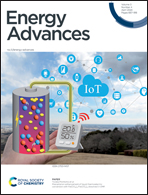Carbon fiber composite electrodes derived from metal organic polyhedra-18 and matrimid for hybrid supercapacitors†
Abstract
Matrimid and metal–organic polyhedra–18 (MOP-18) electrospun composite nanofibers were utilized to fabricate free-standing, electrically conducting, and high-energy density hybrid supercapacitor electrodes. Electrospinning multiple compositions of Matrimid and MOP-18 mixture followed by carbonization and activation with CO2 resulted in C/Cu/Cu2O nanocomposite fibers that exhibited an energy density of up to 12.69 W h kg−1 and a specific capacitance of 253.4 F g−1 at 1 A g−1 current density in 6 M KOH electrolyte. The high energy density of the material can be attributed to the uniform dispersion of redox-active metal/metal oxide particles facilitated by the high solubility of the MOP-18 precursor. The thermal decomposition of MOP-18 during carbonization produced volatile species that increase the surface area and porosity of the resultant carbon allowing for better access of electrolyte ions during charging/discharging. Furthermore, MOP-18 carbonization lowered the ID/IG of the composite electrodes, consistent with increased graphitization.



 Please wait while we load your content...
Please wait while we load your content...